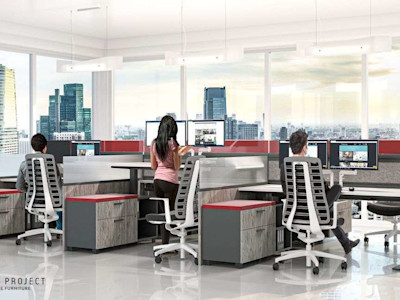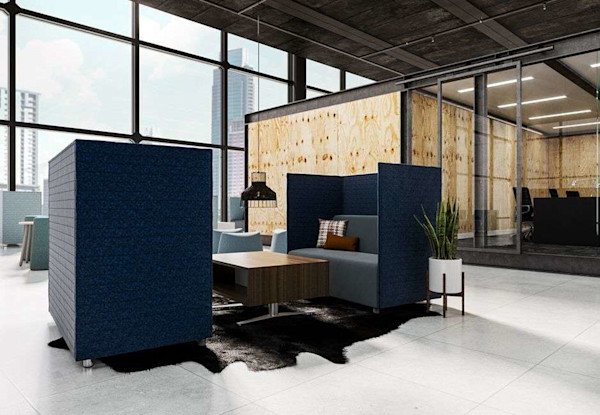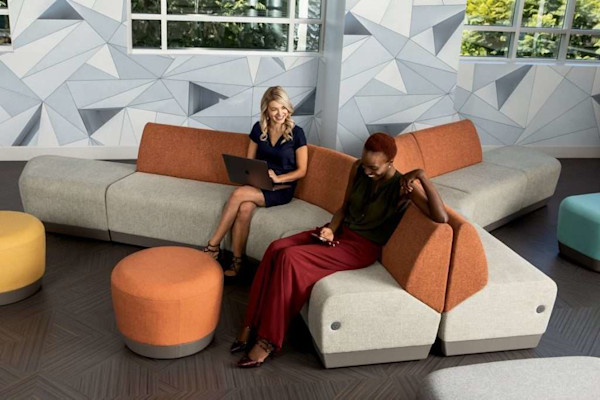Modern Office Space Planning in the New Normal

The layout of your office is an important factor in engagement, productivity, and collaboration. In response to the pandemic, this layout must adapt. In a survey of 185 executives in charge of making decisions affecting office floor plans as we return to work, 80% of large companies anticipated a shift to a hybrid office. It is clear that as you begin modern office space planning it should include a continued hybrid working model. The office has changed. Gone are the rows of cubicles and the 40-hour in-office weeks. And more importantly, employee expectations have changed. And companies that are continuing to be successful have responded. These organizations are putting their most important assets first: their people.
The Future of the Office

According to a recent survey, 88 percent of the workforce wants more flexible working hours in the future, and 63 percent want the ability to work in different places. Companies that are looking to the future are already implementing and creating new office solutions. To create flexibility in your office space, include easily reconfigured furniture, unassigned seating, or hot-desking, and technology to meet the needs of an increasingly distributed workforce.
It's time for organizations to put their most important assets first: their people.
There are many factors affecting the future of work. Economic constraints, talent shortages, changing employee expectations, and continued pressure for corporate growth are a few of the reasons. Creating a future-focused workplace will help organizations attract and retain talent. Additionally, operating costs will go down, the organization will be more sustainable, and productivity will improve. Businesses will need to remain agile as the new normal continues to take shape. The needs of your team will change on a daily basis, and organizations need to provide support no matter where they are working. The new way of working will look different in each company, but responding to changes in employee demands and expectations needs to be a top priority. Any change is difficult. But the focus on health and flexibility is essential to ensure a thriving workforce.
Moving from Office First to People First

Employee turnover has always affected businesses, but in the wake of the pandemic, the numbers speak for themselves. In the 2021 Bureau of Labor Statistics report, the overall turnover rate is 57.3%. This is staggering. If your organization has 100 employees, expect to lose 57. Now more than ever, it is time for organizations to put their employees first if they want to ensure continuity in their organizations.
Flexibility and a positive culture are the keys to success.
Putting your employees first will look different in every office. Survey your team to get an idea of what their needs and desires really are. Surveys show that these needs are often different by generation and gender, so proposing multiple solutions may best fit a diverse workforce. For example, 55% of millennials question returning to the office, while only 36% of the baby boomer generation feel the same. And men are more comfortable returning to the office than women. But these are just statistical averages, so talking to your team will help shape company policies best for your office.
Office Floor Plans to Attract Talent

It is clear that retaining employees and attracting new ones is critical to the success of business post-COVID. So what are employees looking for in an office layout? Over half of employees prefer a private working space, although the trend in office layouts is towards the open office concept. The most common complaint about open office workspaces is increased interruptions and decreased productivity. Creating private, personal areas within these existing open floor plans can help address these concerns.
Engaged employees are productive employees.
New employees are still seeking collaboration and a fun office environment. So including areas in your layout where employees can come together is also important. A variety of office spaces help employees complete different types of work. Adding spaces for brainstorming, one on one planning or large group huddles should also be considered in your office floor plan. In fact, 51% of millennials, who will be shaping the workplace in the near future, prefer to meet and interact with their colleagues in person.
Modern Office Space Planning for the Hybrid Workforce

The hybrid workplace is an after-effect of the pandemic that is here to stay. Employees are looking for increased flexibility, and when talent is in demand, employers must respond. This change can have a positive effect on your office floor plan. There may be less physical space needed to effectively house an overall decrease in the number of employees on a daily basis. This decrease could mean downsizing office space or adding more areas that can increase collaboration and engagement. A hybrid workplace looks different in every organization, from the number of days an employee is in the office, to the percent of the team that works from home. But in every workplace, flexibility and a positive culture are the keys to success. “Making the office a healthy, fun, and social space encourages those who work remotely to want to come into the office,” said Leslie Saul, owner of an architect and interior design firm in Massachusetts. A sense of community is important no matter how diverse the workforce is. Companies that lack a positive sense of community are seeing turnover increase at an alarming rate.
Focus on Efficiency

Designing an office with the needs of your team in mind is extremely important. But no office redesign should happen without focusing on what will make your team the most productive. Consider letting the purpose of the work shape the space. For example, are multiple people involved from different levels of the organization to bring a project to completion? Create an area where collaboration can occur to facilitate teamwork. Is quiet and focus required for detailed problem-solving? Include private office spaces or acoustic furniture to cut down on noise and distractions. A sign of a healthy business and workplace culture is increased productivity. Workers who report a high-level engagement are more efficient and motivated at work. A poorly designed office can have the opposite effect. Often these outdated spaces lead to unnecessary stress, disagreements, anxiety, and even physical discomfort. In this volatile time of high turnover, companies can't afford to wait. It's time to create an office space where your employees can be at their best. Engaged employees are productive employees. And effectively planning the right office layout will create both. Design your modern office today with StrongProject. Creative Employees Don't Want Your Open Office Plan Encouraging Interaction Through Office Design



